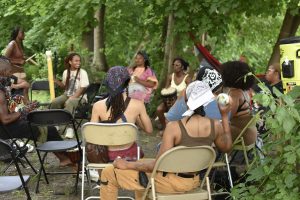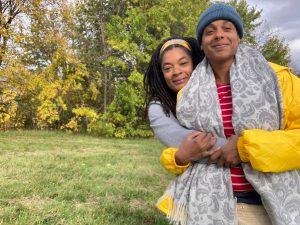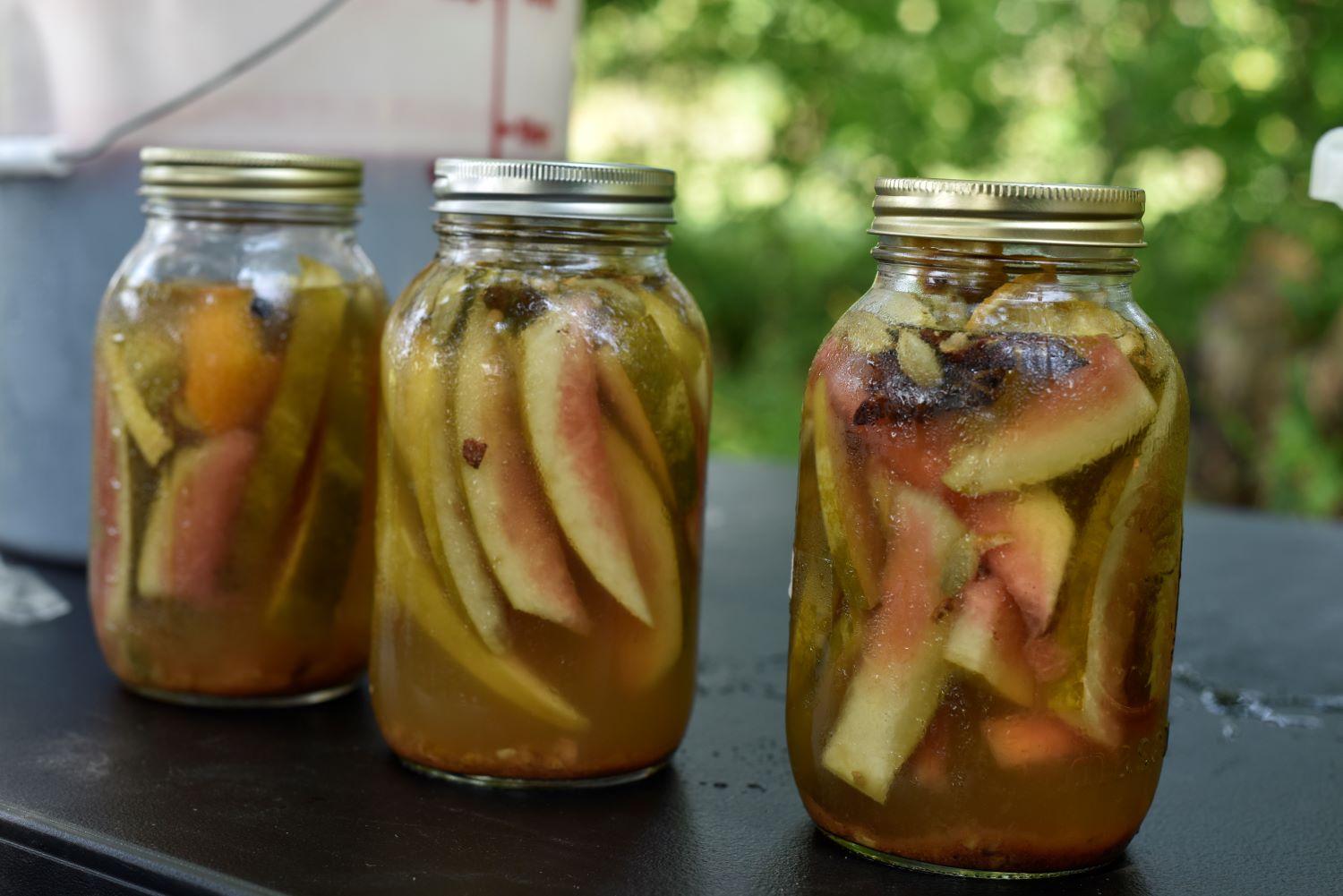What is theJOYproject?
More than a community garden, though not exactly a farm; theJOYproject is more what we see to be a living archive of Afro-Atlantic agriculture and foodways. Now in its third growing season, theJOYproject has become a pivotal element in Detroit’s rich Urban Farming ecosystem. The creation of Josmine Evans and Gabrielle Knox, the space is located in the Historic North End neighborhood at 1105 Alger Street, the space invites family, friends, neighbors, teachers, and community to remember Indigenous and ancestral practices, while allowing them to savor produce rarely grown in modern Western contexts. Visitors also hear stories about Black and Brown peoples’ current and historical relationship to seed and soil. Through weekly volunteer days and regular programming like farm to table dinners, Watermelon Day, skillshares, and Fannie Lou Hamer Day (the annual harvest festival), the community engages in conversation and storytelling through food. These moments cement our connections to our heritage and the legacies of the past by embracing our growth and current experiences of the world as deeply connected to our continuous relationships to growing food.

4 Pillars
Our campus is a live museum featuring four main exhibits: Reconciliation, Restoration, Recognition, and Remembering.
Each exhibit is reflected on the campus by various garden sections. Each of these curated annual or perennial crops speak to the very personal relationship of plants to cultural foodways and traditions.
Recognition
Though theJOYproject centers on the African Atlantic experience, we are well aware that both our past and present experience of life in America has never happened in a vacuum.
The Recognition exhibit is located near the entrance to the campus and features an altar/offering/demo garden displaying the deeply cultural and spiritual Indigenous Three Sisters method of agricultural polyculture of growing squash, beans and corn together in mounds. The Three Sisters Garden serves as a living land acknowledgment of Detroit/Waawiyaatanong, a celebration of the Anishinaabe people and a recognition and honoring of the original stewards of this land.
As we walk our community through this exhibit, it gives us an opportunity to uplift the Three Sisters Method as indigenous ancestral technology . Companion Planting, otherwise known as plant diversity or polyculture allows us to mitigate the consequences that come with monoculture (single plant) crops and reject the pitfalls and dangers of large scale commercialized operations which deplete the soil and jeopardize food safety and ecosystem sustainability.
In a monoculture operation, acres of land are used exclusively to grow one single cropThink for example of passing by fields here in the midwest where all you see is corn growing for miles. This growing method strips the soil of its nitrogen content. Commercial growers remedy this issue with manufactured nitrogen fertilizers. The use of those fertilizers combined with extreme tilling of the topsoil causes runoff and erosion that pollutes waterways with high levels of nitrogen, resulting in algae blooms that suffocate fish and other animals living in the water.
The Ancestral technology of the Three Sisters Method is rooted in community care. Soil health and the deep understanding of how plants like people can support each other and the land is essential to regenerative and restorative agricultural and cultural practice.
To illustrate how this works, while corn, a heavy nitrogen feeder, strips the soil, by growing beans alongside the corn, the beans act as nitrogen fixers, thus returning nitrogen to the soil naturally. The corn in turn acts as a natural trellis system, providing the bean vines with a foundation to grow up and around the corn. Further adding to this relationship, being surrounded by those bean vines helps the corn stalks to withstand strong winds that might otherwise knock them down. The other sister, Squashgrows low around the base of the corn and beans, its large leaves shade the soil allowing it to retain moisture, minimizing irrigation needs and its prickly stems deter potential pests. Together these three plants participate in a symbiotic relationship, sharing space, giving and receiving for mutual benefit. This exhibit then not only shows us how Indigenous technology can help us better steward and cultivate the land it also provides an opportunity for us to reflect on how we behave in community with each other as family, neighbors and citizens by asking ourselves, “how can we best share space, resources and of our own selves for our mutual benefit?“
Remembering
This section of raised beds features plants that have been integral and influential in the Black diasporic culinary cultural experience, such as: okra; black eyed peas; collard greens; sweet potatoes; tomato; hot peppers and a variety of West African and Caribbean leafy greens. This heritage section offers visitors an opportunity to commune with our plant ancestors and share their stories along with our own as we remember. We see these remembrances as perhaps a lived memory of a Great Migration or like a baby visiting grand and great grandparents during the summer and finding seemingly unending rows of abundance in the yards of their loved ones; or maybe they recall a scene from a movie or a book written by Alice Walker, Zora Neal Hurston or Gloria Naylor.
This exhibit aims to awaken a sense of nostalgia for a time and place whene Black folks had a much more intimate relationship with their foods. The seeds sown in this section are chosen by Josmine to create a living memoir and record of the movements of plants and their people. Collard greens grown from seed collected from Josmine’s own grandmother tell the story of a determined young Black woman who took a solo trip from Farmville, VA to California in the late 40s, by train, to start a new life refusing to allow a racist, sexist society to use her dark skin and gender to keep her from her dreams and desires of a life on her own terms. Black eyed peas are grown from seed carried to the Americas by enslaved Africans from Mali in the 1800s, made available to us by the descendants of those Africans who continued to grow and protect that seed generation after generation. Our Fish Peppers come from the Black culinary community of the Chesapeake Bay Area. They are a part of the legacy of Horace Pippin, a Philly born WWI vet, author, and artist who engaged in alternative medicine and alternative economies, using seeds as currency to ensure his wellness when racist medical institutions denied him proper care after being wounded in combat. The plants growing in the Remembering Exhibit exhibit remind us that Black folks have long partnered with plants for liberation and joy.
Reconciliation
This section of garden has in-ground row beds filled with a mixing of perennials, yearly annuals, seasonal highlights and experiments curated by Gabby. In the development of this space they utilized no-till techniques, adding organic materials and cover crops. This exhibit explores how we can reconcile the ways that bigAg (large scale industrial agricultural ventures) exploits and damages land and soil. Many of the plants on display, like watermelon and cotton, have been weaponized in the oppression of humans to the point that even today many people still carry shame and trauma that disrupts their ability to maintain a healthy, joyful relationship with those plants. Cared for with the intention of reparations and atonement we remember AND we Reconcile. Here, giving more life to the conversation and more freedom to the plants, from this land, whose seeds we save and store.
Restoration
The Restoration exhibit is a circular perennial garden where native plants, healing herbs and flowering perennials surround a paver patio. Here we collaborate choosing a variety of herbs and flowers of medicinal value arranged to support this space of healing and restoration. The paved patio area holds space for personal and community activities, allowing participants to invite nature into healing practices that restore the balance of the mind, body and spirit. This exhibit also functions as a pollinator garden, providing pollen, nectar and blooms from spring through fall for bees and other bugs that help us grow abundant harvests. As we reflect on our Pillars and the exhibits that shape theJOYproject , Recognition, Remembering, Reconciliation, and Restoration this is our way of communicating the process of healing that is constant.
Community Resilience
TheJOYproject campus is located on land purchased from the DLBA, where homes and utilities were demolished and disconnected.Though not having DTE or DWSD services can present challenges in irrigating crops and hosting events, we welcome the situation as an opportunity to practice a level of off-grid sovereignty, by harvesting rainwater for our plants and sunlight to produce power. Our water catchment and solar integration is being replicated within Detroit’s urban farming community by the University of Michigan who used our design to secure themselves a sizable grant from the NSF to replicate this model for other farmers across the city.
As a space intentionally created for the manifestation and cultivation of connection, healing, education, experimentation, imagination, and love, we invite you to come and experience for yourself the JOY of being reminded that we too are a part of nature, that we too are an important part of history, and that we too will be a part of shaping the future.
Learn more and connect with theJOYproject at https://www.joytheproject.com/ or find us on Instagram @joy_theproject

Gabrielle Knox, Co-founder of Thejoyproject growers is a thinker, learning and creating models of mutual aid as functions to an experimental philosophy in community sustainability and local economies. A farmer and Professional Neighbor living and building within their Detroit neighborhood, modeling cooperatively structured businesses and mission based culturally relevant Developments as praxis.
Josmine Evans, Co founder of Thejoyproject Growers weaves together food, culture, and storytelling through her work at Indigo Culinary Co. and The Joy Project. Initially exploring her identity through family recipes, Evans’ journey evolved into a mission of rediscovering and preserving the ancestral heritage of the African diaspora. Her travels across the African Atlantic have enriched her with diverse culinary traditions and stories, which she shares to reconnect communities with their cultural roots. As a cultural preservationist, Evans emphasizes the importance of learning from the past to inform the future, resisting the erasure of Black foodways and highlighting the contributions of Black and Indigenous people of color.


